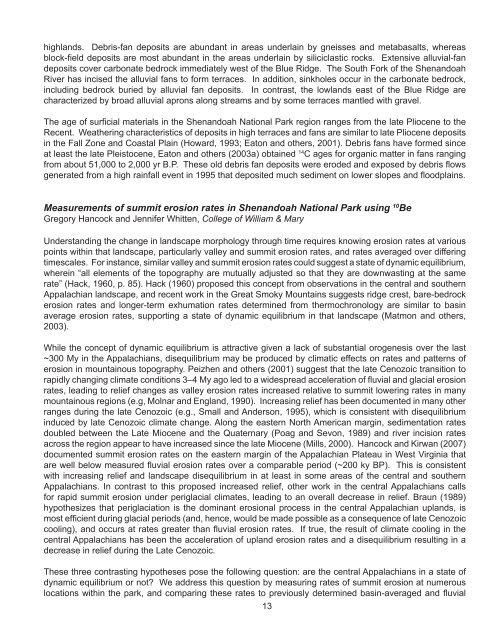Geology of the Shenandoah National Park Region - Csmres Jmu ...
Geology of the Shenandoah National Park Region - Csmres Jmu ...
Geology of the Shenandoah National Park Region - Csmres Jmu ...
You also want an ePaper? Increase the reach of your titles
YUMPU automatically turns print PDFs into web optimized ePapers that Google loves.
highlands. Debris-fan deposits are abundant in areas underlain by gneisses and metabasalts, whereas<br />
block-field deposits are most abundant in <strong>the</strong> areas underlain by siliciclastic rocks. Extensive alluvial-fan<br />
deposits cover carbonate bedrock immediately west <strong>of</strong> <strong>the</strong> Blue Ridge. The South Fork <strong>of</strong> <strong>the</strong> <strong>Shenandoah</strong><br />
River has incised <strong>the</strong> alluvial fans to form terraces. In addition, sinkholes occur in <strong>the</strong> carbonate bedrock,<br />
including bedrock buried by alluvial fan deposits. In contrast, <strong>the</strong> lowlands east <strong>of</strong> <strong>the</strong> Blue Ridge are<br />
characterized by broad alluvial aprons along streams and by some terraces mantled with gravel.<br />
The age <strong>of</strong> surficial materials in <strong>the</strong> <strong>Shenandoah</strong> <strong>National</strong> <strong>Park</strong> region ranges from <strong>the</strong> late Pliocene to <strong>the</strong><br />
Recent. Wea<strong>the</strong>ring characteristics <strong>of</strong> deposits in high terraces and fans are similar to late Pliocene deposits<br />
in <strong>the</strong> Fall Zone and Coastal Plain (Howard, 1993; Eaton and o<strong>the</strong>rs, 2001). Debris fans have formed since<br />
at least <strong>the</strong> late Pleistocene, Eaton and o<strong>the</strong>rs (2003a) obtained 14 C ages for organic matter in fans ranging<br />
from about 51,000 to 2,000 yr B.P. These old debris fan deposits were eroded and exposed by debris flows<br />
generated from a high rainfall event in 1995 that deposited much sediment on lower slopes and floodplains.<br />
Measurements <strong>of</strong> summit erosion rates in <strong>Shenandoah</strong> <strong>National</strong> <strong>Park</strong> using 10 Be<br />
Gregory Hancock and Jennifer Whitten, College <strong>of</strong> William & Mary<br />
Understanding <strong>the</strong> change in landscape morphology through time requires knowing erosion rates at various<br />
points within that landscape, particularly valley and summit erosion rates, and rates averaged over differing<br />
timescales. For instance, similar valley and summit erosion rates could suggest a state <strong>of</strong> dynamic equilibrium,<br />
wherein “all elements <strong>of</strong> <strong>the</strong> topography are mutually adjusted so that <strong>the</strong>y are downwasting at <strong>the</strong> same<br />
rate” (Hack, 1960, p. 85). Hack (1960) proposed this concept from observations in <strong>the</strong> central and sou<strong>the</strong>rn<br />
Appalachian landscape, and recent work in <strong>the</strong> Great Smoky Mountains suggests ridge crest, bare-bedrock<br />
erosion rates and longer-term exhumation rates determined from <strong>the</strong>rmochronology are similar to basin<br />
average erosion rates, supporting a state <strong>of</strong> dynamic equilibrium in that landscape (Matmon and o<strong>the</strong>rs,<br />
2003).<br />
While <strong>the</strong> concept <strong>of</strong> dynamic equilibrium is attractive given a lack <strong>of</strong> substantial orogenesis over <strong>the</strong> last<br />
~300 My in <strong>the</strong> Appalachians, disequilibrium may be produced by climatic effects on rates and patterns <strong>of</strong><br />
erosion in mountainous topography. Peizhen and o<strong>the</strong>rs (2001) suggest that <strong>the</strong> late Cenozoic transition to<br />
rapidly changing climate conditions 3–4 My ago led to a widespread acceleration <strong>of</strong> fluvial and glacial erosion<br />
rates, leading to relief changes as valley erosion rates increased relative to summit lowering rates in many<br />
mountainous regions (e.g, Molnar and England, 1990). Increasing relief has been documented in many o<strong>the</strong>r<br />
ranges during <strong>the</strong> late Cenozoic (e.g., Small and Anderson, 1995), which is consistent with disequilibrium<br />
induced by late Cenozoic climate change. Along <strong>the</strong> eastern North American margin, sedimentation rates<br />
doubled between <strong>the</strong> Late Miocene and <strong>the</strong> Quaternary (Poag and Sevon, 1989) and river incision rates<br />
across <strong>the</strong> region appear to have increased since <strong>the</strong> late Miocene (Mills, 2000). Hancock and Kirwan (2007)<br />
documented summit erosion rates on <strong>the</strong> eastern margin <strong>of</strong> <strong>the</strong> Appalachian Plateau in West Virginia that<br />
are well below measured fluvial erosion rates over a comparable period (~200 ky BP). This is consistent<br />
with increasing relief and landscape disequilibrium in at least in some areas <strong>of</strong> <strong>the</strong> central and sou<strong>the</strong>rn<br />
Appalachians. In contrast to this proposed increased relief, o<strong>the</strong>r work in <strong>the</strong> central Appalachians calls<br />
for rapid summit erosion under periglacial climates, leading to an overall decrease in relief. Braun (1989)<br />
hypo<strong>the</strong>sizes that periglaciation is <strong>the</strong> dominant erosional process in <strong>the</strong> central Appalachian uplands, is<br />
most efficient during glacial periods (and, hence, would be made possible as a consequence <strong>of</strong> late Cenozoic<br />
cooling), and occurs at rates greater than fluvial erosion rates. If true, <strong>the</strong> result <strong>of</strong> climate cooling in <strong>the</strong><br />
central Appalachians has been <strong>the</strong> acceleration <strong>of</strong> upland erosion rates and a disequilibrium resulting in a<br />
decrease in relief during <strong>the</strong> Late Cenozoic.<br />
These three contrasting hypo<strong>the</strong>ses pose <strong>the</strong> following question: are <strong>the</strong> central Appalachians in a state <strong>of</strong><br />
dynamic equilibrium or not? We address this question by measuring rates <strong>of</strong> summit erosion at numerous<br />
locations within <strong>the</strong> park, and comparing <strong>the</strong>se rates to previously determined basin-averaged and fluvial<br />
13


